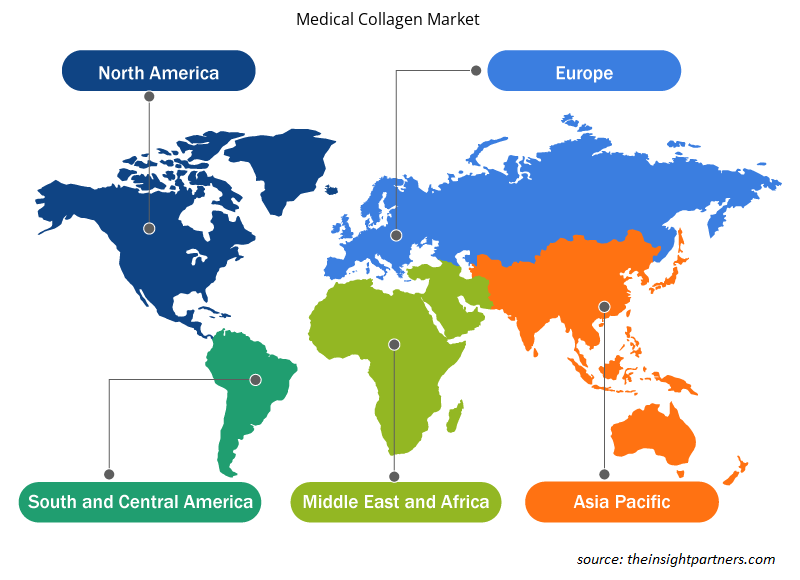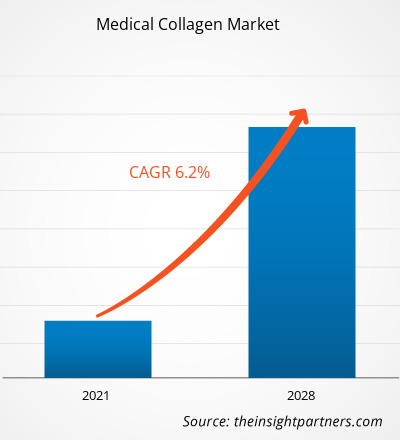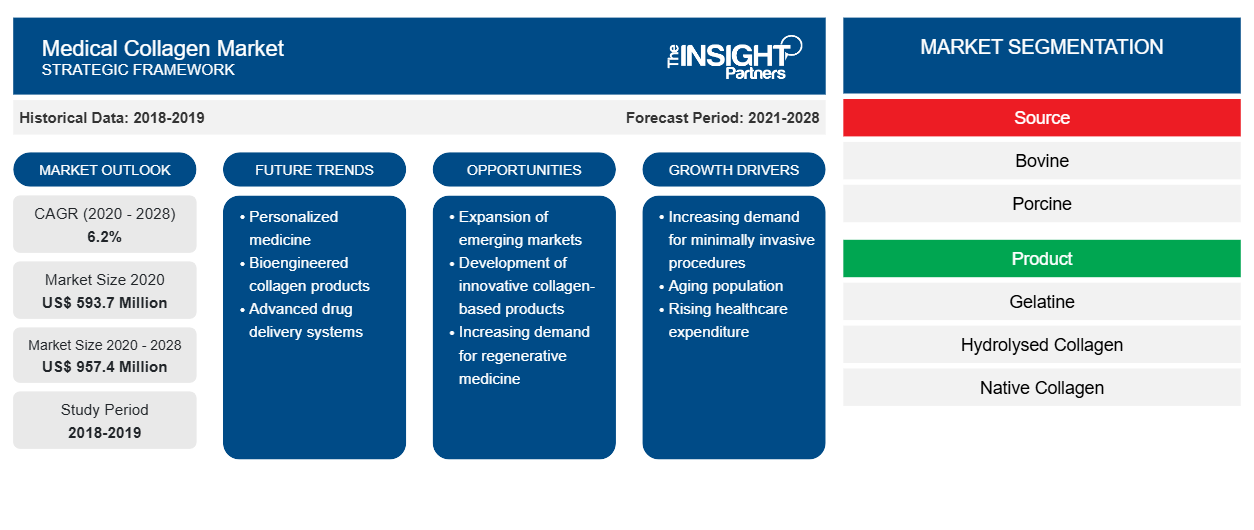Le marché du collagène médical devrait atteindre 957,4 millions de dollars américains d'ici 2028, contre 593,7 millions de dollars américains en 2020 ; il devrait croître à un TCAC de 6,2 % de 2021 à 2028.
Le collagène est la protéine la plus abondante dans le corps humain. Il est principalement présent dans les tissus fibreux tels que les ligaments, la peau, les tendons, la cornée, les vaisseaux sanguins, les os, les cartilages et les disques intervertébraux. Le collagène médical est un matériau biocompatible à faible immunogénicité. Le collagène a de bonnes propriétés hémostatiques et facilite la cicatrisation des plaies. Il est utilisé dans les cultures cellulaires car il favorise la prolifération cellulaire dans les structures en treillis et le domaine de liaison cellulaire. Le collagène médical est largement utilisé dans des applications telles que la cicatrisation des plaies, l'ingénierie tissulaire, les chirurgies reconstructives, les greffes osseuses et les chirurgies esthétiques. La croissance du marché du collagène médical est attribuée à des facteurs tels que l'augmentation des applications du collagène dans l'industrie médicale et l'augmentation des approbations de la FDA et des lancements de produits. Cependant, les rappels de produits entravent la croissance du marché.
Personnalisez ce rapport en fonction de vos besoins
Vous bénéficierez d'une personnalisation gratuite de n'importe quel rapport, y compris de certaines parties de ce rapport, d'une analyse au niveau des pays, d'un pack de données Excel, ainsi que de superbes offres et réductions pour les start-ups et les universités.
-
Obtenez les principales tendances clés du marché de ce rapport.Cet échantillon GRATUIT comprendra une analyse de données, allant des tendances du marché aux estimations et prévisions.
Couverture du rapport
Informations sur le marché
Applications croissantes du collagène dans l'industrie médicale
Le collagène est la protéine présente dans les tissus conjonctifs du corps. C'est la protéine la plus abondante chez les mammifères, représentant environ 25 à 35 % de la teneur en protéines de l'ensemble du corps. Le collagène étant faiblement antigénique et biodégradable, il présente une excellente biocompatibilité. Il s'agit donc d'une ressource essentielle dans les applications médicales.
La matrice extracellulaire cardiaque (ECM) est composée de collagène fibrillaire qui assure la transmission de la force, préserve l'intégrité du myocarde et soutient la géométrie des myocytes. Plusieurs études ont prouvé que la consommation de suppléments de collagène contribue à réduire le risque de maladies cardiaques.
Le collagène est l'un des principaux composants des formules cosmétiques car il possède des propriétés hydratantes, régénérantes et filmogènes. Le collagène a une excellente capacité à lier l'eau, ce qui contribue à maintenir une teneur en eau adéquate dans la peau tout au long de la journée, ce qui rend la peau hydratée et adoucie. De plus, les produits de comblement à base de collagène sont largement utilisés en médecine esthétique. L'injection sous-cutanée de collagène soluble améliore la qualité et la densité de la peau, réparant ainsi ses défauts dermatologiques.
Les biomatériaux à base de collagène ont une large gamme d'applications in vivo et in vitro. Le collagène a été largement utilisé pour développer des substituts de greffe osseuse synthétique pour la colonne vertébrale, les extrémités et les dents. De plus, des échafaudages de collagène sont développés pour imiter et régénérer les tissus natifs et sont rapidement adoptés pour la réparation du cartilage.
Le collagène est naturellement impliqué dans le processus de cicatrisation des plaies et l'utilisation de pansements à base de collagène offre plusieurs avantages pour la fermeture des plaies aiguës et chroniques. De plus, les pansements à base de collagène peuvent contrôler l'humidité de la plaie, soit en absorbant, soit en fournissant de l'humidité. Ainsi, le collagène est largement utilisé dans les pansements, les particules et les échafaudages fluides pour traiter les plaies aiguës et chroniques.
Cette large gamme d’applications du collagène dans l’industrie médicale favorise la croissance du marché.
Informations basées sur les produits
Le marché du collagène médical, par source, est segmenté en bovin, porcin et autres. Le segment bovin détenait la plus grande part du marché en 2020 et il devrait enregistrer le TCAC le plus élevé du marché au cours de la période de prévision.
Informations basées sur les produits
En fonction du produit, le marché du collagène médical est segmenté en gélatine, collagène hydrolysé, collagène natif et autres. Le segment de la gélatine détenait la plus grande part de marché en 2020 et devrait enregistrer le TCAC le plus élevé du marché au cours de la période de prévision.
Informations basées sur les applications
En fonction des applications, le marché du collagène médical est segmenté en hémostatiques, greffes vasculaires, échafaudages tissulaires, réparation du cartilage, soins des plaies, greffes osseuses, diagnostics et autres. Le segment des soins des plaies détenait la plus grande part de marché en 2020, et le segment des greffes osseuses devrait enregistrer le TCAC le plus élevé du marché au cours de la période de prévision.
Les lancements et les approbations de produits sont les stratégies couramment adoptées par les entreprises pour étendre leur présence mondiale et leurs portefeuilles de produits. La collaboration est l'une des principales stratégies adoptées par les acteurs du marché du collagène médical pour élargir leur clientèle dans le monde entier, ce qui leur permet à leur tour de maintenir leur nom de marque à l'échelle mondiale.
Aperçu régional du marché du collagène médical
Les tendances régionales et les facteurs influençant le marché du collagène médical tout au long de la période de prévision ont été expliqués en détail par les analystes d’Insight Partners. Cette section traite également des segments et de la géographie du marché du collagène médical en Amérique du Nord, en Europe, en Asie-Pacifique, au Moyen-Orient et en Afrique, ainsi qu’en Amérique du Sud et en Amérique centrale.

- Obtenez les données régionales spécifiques au marché du collagène médical
Portée du rapport sur le marché du collagène médical
| Attribut de rapport | Détails |
|---|---|
| Taille du marché en 2020 | 593,7 millions de dollars américains |
| Taille du marché d'ici 2028 | 957,4 millions de dollars américains |
| Taux de croissance annuel composé mondial (2020-2028) | 6,2% |
| Données historiques | 2018-2019 |
| Période de prévision | 2021-2028 |
| Segments couverts |
Par source
|
| Régions et pays couverts |
Amérique du Nord
|
| Leaders du marché et profils d'entreprises clés |
|
Densité des acteurs du marché du collagène médical : comprendre son impact sur la dynamique commerciale
Le marché du collagène médical connaît une croissance rapide, tirée par la demande croissante des utilisateurs finaux en raison de facteurs tels que l'évolution des préférences des consommateurs, les avancées technologiques et une plus grande sensibilisation aux avantages du produit. À mesure que la demande augmente, les entreprises élargissent leurs offres, innovent pour répondre aux besoins des consommateurs et capitalisent sur les tendances émergentes, ce qui alimente davantage la croissance du marché.
La densité des acteurs du marché fait référence à la répartition des entreprises ou des sociétés opérant sur un marché ou un secteur particulier. Elle indique le nombre de concurrents (acteurs du marché) présents sur un marché donné par rapport à sa taille ou à sa valeur marchande totale.
Les principales entreprises opérant sur le marché du collagène médical sont :
- DSM
- Société Integra Lifesciences
- MATRICE DE COLLAGÈNE, INC.
- ENCOLLER
- COLLAGEN SOLUTIONS PLC
Avis de non-responsabilité : les sociétés répertoriées ci-dessus ne sont pas classées dans un ordre particulier.

- Obtenez un aperçu des principaux acteurs du marché du collagène médical
Marché du collagène médical – par source
- Bovine
- Porcin
- Autres
Marché du collagène médical – par produit
- Gélatine
- Collagène hydrolysé
- Collagène natif
- Autres
Marché du collagène médical – par application
- Soins des plaies
- Greffes osseuses
- Échafaudages tissulaires
- Réparation du cartilage
- Hémostatiques
- Diagnostic
- Greffes vasculaires
- Autre
Marché du collagène médical – par géographie
-
Amérique du Nord
- NOUS
- Canada
- Mexique
-
Europe
- France
- Allemagne
- Italie
- ROYAUME-UNI
- Espagne
- Reste de l'Europe
-
Asie-Pacifique (APAC)
- Chine
- Inde
- Corée du Sud
- Japon
- Australie
- Reste de l'Asie-Pacifique
-
Moyen-Orient et Afrique (MEA)
- Afrique du Sud
- Arabie Saoudite
- Émirats arabes unis
- Reste du Moyen-Orient et de l'Afrique
-
Amérique du Sud et Amérique centrale
- Brésil
- Argentine
- Reste de l'Amérique du Sud et de l'Amérique centrale
Profils d'entreprise
- DSM
- Société Integra Lifesciences
- Matrice de collagène Inc.
- Encoll
- Collagen Solutions Plc
- Innocol
- Symatese
- Gelita AG
- Collplant Biotechnologies Ltée
- Croda International PLC.
- Analyse historique (2 ans), année de base, prévision (7 ans) avec TCAC
- Analyse PEST et SWOT
- Taille du marché Valeur / Volume - Mondial, Régional, Pays
- Industrie et paysage concurrentiel
- Ensemble de données Excel
Rapports récents
Rapports connexes
Témoignages
Raison d'acheter
- Prise de décision éclairée
- Compréhension de la dynamique du marché
- Analyse concurrentielle
- Connaissances clients
- Prévisions de marché
- Atténuation des risques
- Planification stratégique
- Justification des investissements
- Identification des marchés émergents
- Amélioration des stratégies marketing
- Amélioration de l'efficacité opérationnelle
- Alignement sur les tendances réglementaires























 Obtenez un échantillon gratuit pour - Marché du collagène médical
Obtenez un échantillon gratuit pour - Marché du collagène médical